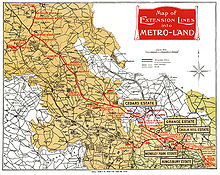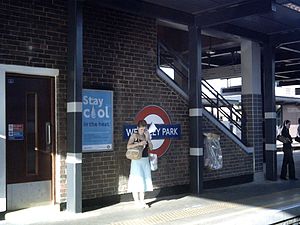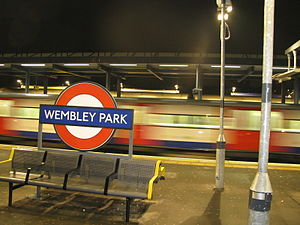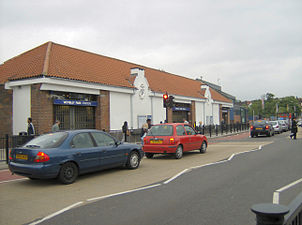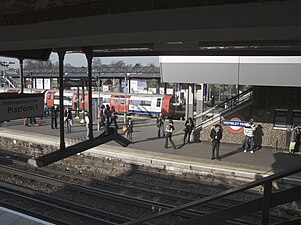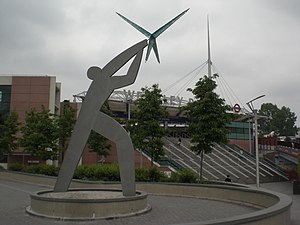
The Metropolitan line, colloquially known as the Met, is a London Underground line between Aldgate in the City of London and Amersham and Chesham in Buckinghamshire, with branches to Watford in Hertfordshire and Uxbridge in Hillingdon. Printed in magenta on the tube map, the line is 41.4 miles (66.7 km) in length and serves 34 stations. Between Aldgate and Finchley Road, the track is mostly in shallow "cut and cover" tunnels, apart from short sections at Barbican and Farringdon stations. The rest of the line is above ground, with a loading gauge of a similar size to those on main lines. Just under 94 million passenger journeys were made on the line in 2019.

The Bakerloo line is a London Underground line that runs from Harrow & Wealdstone in suburban north-west London to Elephant & Castle in south London, via the West End. Printed in brown on the Tube map, it serves 25 stations, 15 of which are underground, over 23.2 kilometres (14.4 mi). It runs partly on the surface and partly through deep-level tube tunnels.

The Jubilee line is a London Underground line that runs between Stanmore in suburban north-west London and Stratford in east London, via the Docklands, South Bank and West End. Opened in 1979, it is the newest line on the Underground network, although some sections of track date back to 1932 and some stations to 1879.

Dollis Hill is a London Underground station at Dollis Hill near to Willesden and Gladstone Park of the London Borough of Brent. It is on the Jubilee line, between Neasden and Willesden Green stations and is in Travelcard Zone 3. Metropolitan line trains pass through the station without stopping here.

Embankment is a London Underground station in the City of Westminster, known by various names during its history. It is served by the Bakerloo, Circle, District and Northern lines. On the Bakerloo line and the Charing Cross branch of the Northern line, the station is between Waterloo and Charing Cross stations; on the Circle and District lines, it is between Westminster and Temple and is in Travelcard Zone 1. The station has two entrances, one on Victoria Embankment and the other on Villiers Street. The station is adjacent to Victoria Embankment Gardens and is close to Charing Cross station, Embankment Pier, Hungerford Bridge, Cleopatra's Needle, the Royal Air Force Memorial, the Savoy Chapel and Savoy Hotel and the Playhouse and New Players Theatres.

Baker Street is a London Underground station at the junction of Baker Street and the Marylebone Road in the City of Westminster. It is one of the original stations of the Metropolitan Railway (MR), the world's first underground railway, opened on 10 January 1863.

Kingsbury is a London Underground station in northwest London, England. It is on the Jubilee line between Queensbury and Wembley Park stations, in Zone 4, in the borough of Brent.

Neasden is a London Underground station in Neasden. It is on the Jubilee line, between Wembley Park and Dollis Hill stations. Metropolitan line trains pass through the station but do not stop. The Chiltern Main Line/London to Aylesbury Line runs to the west of the station.

Willesden Green is a London Underground station on Walm Lane in Willesden. It is served by the Jubilee line and is between Dollis Hill and Kilburn stations. Metropolitan line trains also pass through the station, but do not stop. The station is in both Travelcard Zone 2 and Zone 3.

Kilburn is a London Underground station near Brondesbury Park in north-west London. It is on the Jubilee line, between Willesden Green and West Hampstead stations and is in Travelcard Zone 2. The station is on the A5 Kilburn High Road or Shoot-up Hill, approximately 0.1 miles (0.16 km) north of Brondesbury station. Metropolitan line trains typically bypass the station without stopping.

West Hampstead is a London Underground station in West Hampstead. It is located on West End Lane between Broadhurst Gardens and Blackburn Road and is situated in Travelcard Zone 2. It is on the Jubilee line between Kilburn and Finchley Road stations. It is 100 m (110 yd) from West Hampstead station on the London Overground North London line and 200 m (220 yd) from West Hampstead Thameslink station. Metropolitan line trains also pass through the station, but do not stop.

Finchley Road is a London Underground station at the corner of Finchley Road and Canfield Gardens in the London Borough of Camden, north London. It is on the Jubilee line, between West Hampstead and Swiss Cottage stations and on the Metropolitan line between Wembley Park and Baker Street stations. From this station, Metropolitan line trains pass through the Jubilee line stations towards Wembley Park but do not stop in them until there. It is in Travelcard Zone 2.

St. John's Wood is a London Underground station located in St John's Wood in the City of Westminster, north-west London. It was opened in 1939 as a stop on the Bakerloo line. Today St. John's Wood is served by the Jubilee line, between Swiss Cottage and Baker Street stations and is in Travelcard Zone 2. Essentially, St. John's Wood station is a local station with the nearby Metropolitan Line bypassing this station. A journey between St. John's Wood and Baker Street typically takes less than three minutes.

Canons Park is a London Underground station at Canons Park of the London Borough of Harrow, north-west London. It is on the Jubilee line, between Stanmore and Queensbury stations and is in Travelcard Zone 5. It is also the least used station on the Jubilee line with an average of 1.68 million passengers per year.

Stanmore is a London Underground station in Stanmore, north-west London. It is the northern terminus of the Jubilee line and the next station towards south is Canons Park. The station is on the south side of London Road and is in Travelcard Zone 5.

Harrow & Wealdstone is a London Underground and railway station on the Watford DC line and West Coast Main Line in Harrow and Wealdstone in the London Borough of Harrow. It is 11 miles 30 chains (18.31 km) on the line from London Euston station. It is also the northern terminus of the Bakerloo line and the next station towards south is Kenton.
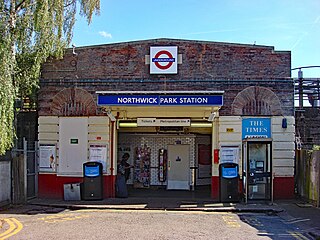
Northwick Park is a London Underground station in Kenton in the London Borough of Brent on the Metropolitan line. It lies between Harrow-on-the-Hill and Preston Road stations and is in Travelcard zone 4. The station takes its name from the nearby public park, Northwick Park.
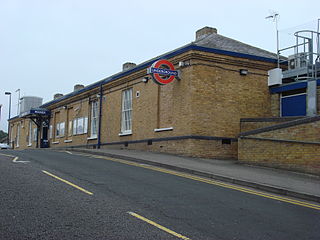
Pinner is a London Underground station. The station was opened in 1885 as part of the Victorian expansion of dormitory suburbs, and was one of the stations included in the Metro-land project in the early 20th century. The site is served by several bus routes including links to the Hatch End railway station which was known as Pinner & Hatch End prior to 1920. Step free facilities were opened in 2008. The station is on the Metropolitan line between Northwood Hills and North Harrow stations, and is in Travelcard Zone 5.
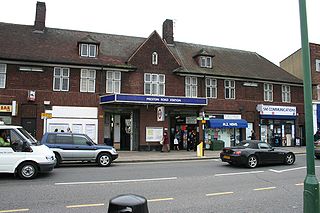
Preston Road is a London Underground station in Preston Road in the London Borough of Brent. It is on the Metropolitan line between Northwick Park and Wembley Park stations and is in Travelcard Zone 4. It serves the local area of Preston in Wembley and parts of Kenton.

Northwood is a station on the Watford branch of the Metropolitan line, in Travelcard Zone 6. The station is located just off the main road through the town, Green Lane. The line serves as the sole continuous link between the town of Northwood and London, key for a region known as Metro-Land.




